Making a Start
My initial attempts at the first exercises of this chapter were made using window cleaning scrim. Although the weave is loose and ideal from this point of view, the colour is dull and my attempt at dyeing it duller still.
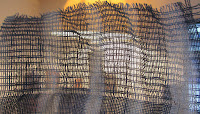 |
| 5:1 |
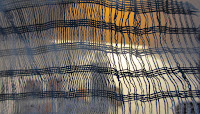 |
| 5:2 |
However there was enough in these images to show me just how delicate and attractive the end result could be. I searched through my various storage places -- I am trying to search these before rushing out to find the perfect thing -- and discovered a smallish piece of white linen even weave which I cut into three 12cm wide strips. It's always a dilemma deciding what size something needs to be for a sample. This in fact turned out to be just right.
I experimented with dyes, using Ocean Blue (a Dylon dye I had in stock) adding a very little black to take away its purple edge. I planned to use just blue and white, which I thought had the potential to be lovely, though I realise there are limitations in losing the mixed colour shown in the course material, where blue, orange and brown featured in the colour palette. In the first dyeing session I painted horizontal stripes, later diagonal ones.
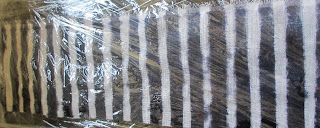 |
| 5:3 |
Exercises 1 and 2
And below are the photographs of both the first and second exercises using the horizontally and diagonally striped linen. The visual effects are very pleasing and versatile. I liked the results from pulling threads in two directions (5:5) and because I have images of the sea in my mind (see Overstrand Beach below) I thought the technique gave a suggestion of waves and ripples. The fabric's qualities worked well with the technique shown in 5:4, producing increasing lightness and transparency as more and more threads were withdrawn.
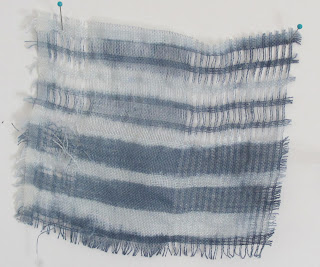 |
| 5:4 |
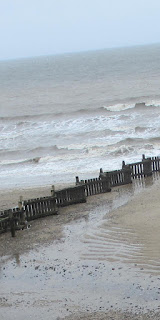 |
| Overstrand Beach |
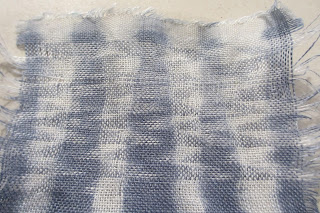 |
5:5
|
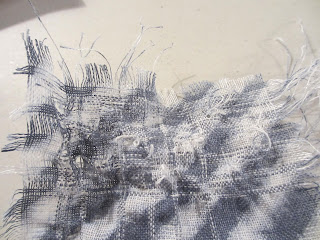 |
| 5:6 |
Image 5:6 shows threads displaced both horizontally and vertically with lines of loops and threads which have been stitched back into the fabric.
Image 5:7 shows two contrasting ideas. On the left rows of vertical threads have been withdrawn on a diagonal then restitched into the fabric creating loops of diminishing sizes. I am attracted to this idea: it creates lightness and movement echoing the lively foaming quality of the Overstrand foreshore. This technique also uses the linen's crispness and slub-like nature to good effect.
On the right horizontal rows of threads have been withdrawn then woven back into the fabric creating loose folds. The threads have then been knotted. This technique does not create such a light look as the one on the left but it would be interesting to see what effect could be achieved by making
many such folds.
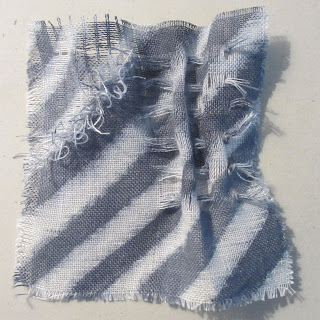 |
5:7
Below in image 5:8 the qualities of the linen can again be appreciated: a crisp wiryness and an inclination by each thread to go its own way.
|
 |
| 5:8 |
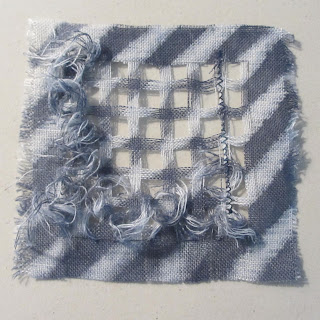 |
| 5:9 |
Above in image 5:9 the threads have been loosely twisted and knotted into the grid. The natural spring of the warp and weft threads is almost impossible to control. I put machine stitching on hold whilst I thought about it, feeling that the firm regularity of the machine stitching was at odds with the linen fibre's behaviour. As I write this I realise that a more varied approach to machine stitching is needed and in 5:10 I have tried varying the density of both the white and variegated blue threads. The wing needle was a great help here. Perhaps the addition of hand embroidered stitching would be good too. I'll have to try this out. Another opinion and some guidance would be helpful.
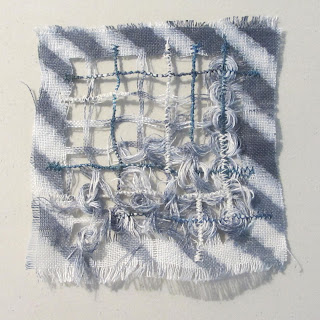 |
| 5:10 |
Follow-up:
- weaving threads and other materials into left-hand technique in 5:7 eg slub-like silk threads from dupion and thin strips of cellophane
- on samples such as 5:10 further experimentation with machine stitching using thicker threads or creating buildups of stitching with thinner threads, also handstitching












Lots of beautiful samples Lesley. I too found it hard trying to colour window cleaning scrim. I love your colour scheme with the blue/black and white and your work connects beautifully to the photographs of the beach. You have been so inventive in how you have used the techniques, which could be very stiff and regular, but you have managed to make a freer effect with them.
ReplyDelete